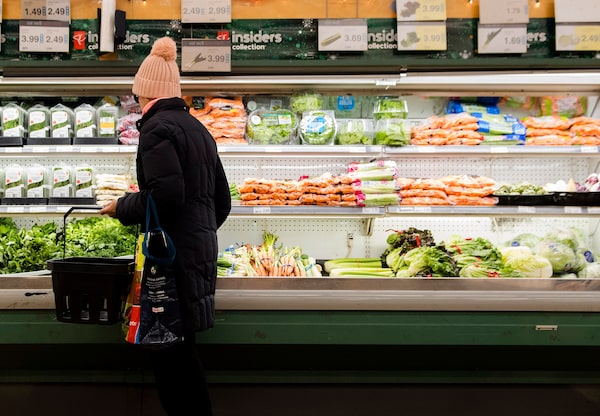
A woman overlooks produce in a grocery store in Toronto, in a Nov. 30, 2018, file photo.Nathan Denette/The Canadian Press
More than 4.4 million Canadians have inadequate or unstable access to nutritious food due to financial constraints, according to a new report – the highest-ever national estimate for food insecurity in Canada.
The figure, which translates into about one in eight households across the country, captures the number of Canadians who reported feeling food insecure between 2017 and 2018. This can range in severity, from feelings of being unable to pay for groceries, to having to skip meals for full days due to affordability.
The report was compiled by PROOF, the University of Toronto’s food insecurity research centre, and released Thursday. PROOF’s previous national estimate for food insecurity was published in 2011, and at that time pegged the figure at four million across Canada.
“We’ve got a bigger number of people living in food insecure situations in Canada than we’ve ever seen – so it’s definitely not getting better,” said Valerie Tarasuk, the principal investigator at PROOF.
“This problem is festering.”
The report draws on data from Statistics Canada, and compiles the responses from more than 103,000 households across the country. Still, Prof. Tarasuk said it’s likely a conservative estimate. The figure does not include data from particularly vulnerable populations, including families living on First Nations reserves, those living in very remote Northern areas or those who are homeless.
The problem is especially pronounced in Nunavut, according to the report. The data show that 57 per cent of households in Nunavut report experiencing some level of food insecurity in the region – up from 52 per cent in 2015-2016. Almost half of those respondents identified themselves this time around as “severely food insecure,” meaning they’ve gone a whole day or more without food.

Household food insecurity in canada
2017-2018
Number of food insecure individuals
4.4 million
incl. 1.2 million children
Per cent of households marginally food insecure
4%
Per cent of households moderately food insecure
5.7%
Per cent of households severely food insecure
3%
JOHN SOPINSKI/THE GLOBE AND MAIL
SOURCE: proof, university of toronto

Household food insecurity in canada
2017-2018
Number of food insecure individuals
4.4 million
incl. 1.2 million children
Per cent of households marginally food insecure
4%
Per cent of households moderately food insecure
5.7%
Per cent of households severely food insecure
3%
JOHN SOPINSKI/THE GLOBE AND MAIL
SOURCE: proof, university of toronto

Household food insecurity in canada
2017-2018
Number of food insecure individuals
4.4 million
incl. 1.2 million children
Per cent of households marginally food insecure
4%
Per cent of households moderately food insecure
5.7%
Per cent of households severely food insecure
3%
JOHN SOPINSKI/THE GLOBE AND MAIL, SOURCE: proof, university of toronto
“I think what’s really concerning is this is just one aspect: food security. But it’s an indication that there are other material things people are deprived of,” said Aluki Kotierk, the president of the Inuit advocacy group Nunavut Tunngavik Incorporated. “People [in Nunavut] have to choose: do they pay for food? For electricity? Do they pay for rent? It’s basic things people have to make choices for."
The report also shows that nearly eight out of 10 children in Nunavut live in food insecure households.
“If we’re not able to provide good food to our children while they’re young, it’s going to have an impact on how they develop, how they do in the education system, how successful they are as employees, and on their health,” she said.
The Nunavut Food Security Coalition website outlines a number of factors affecting food access and availability in the territory, including climate change and changes to wildlife stocks, transportation and high costs of groceries, and low incomes.
Food insecurity is linked with a wide range of broader health and social concerns. One year of living in a severely food insecure household is associated with nine years less of life, said Prof. Tarasuk.
The report also underlines how disproportionately certain populations are affected – namely Indigenous or Black families (28 per cent and 29 per cent, respectively). Families with children, too, were disproportionately affected – meaning some 1.2 million children in Canada are living in food-insecure households.
The report also highlights a problem that many groups have been stressing in recent years: that, increasingly, those who cannot afford food are employed. Of those who identified as food insecure, the majority – 65 per cent – of respondents came from working households.
Our Morning Update and Evening Update newsletters are written by Globe editors, giving you a concise summary of the day’s most important headlines. Sign up today.
 Ann Hui
Ann Hui